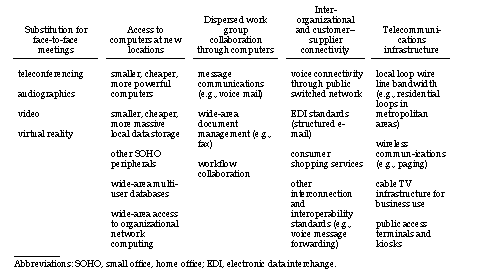

Telecommunications and computers have now merged. New terminology like
"telematics" or "National Information Infrastructure (NII)" can best describe
the marriage, although we will continue to use "telecommunications" in this
report. Computers are attached to networks and embedded within them. Examples
of telecommunications as telematics are cellular mobile telephones, automatic
teller machines, airline reservation systems, electronic cash registers that
update inventory data and order replacement stock, and handheld computers that
transmit and receive wireless messages. Virtually all switched
telecommunications is telematics, since modern telephone switches are in fact
special-purpose computers.
At the same time that telecommunications revolutionizes information flows, it
also changes how people and goods move. Urban highway flows, commercial
aviation, overnight package delivery, trucking, railroads, and international
shipping are increasingly managed through computers and telecommunications that
guide shipments, people, and vehicles.
The changes caused by new applications of telecommunications and transportation
are just beginning:
- Office work becomes possible anywhere people are able to live or travel as
equipment becomes smaller and telecommunications reaches everywhere.
- Warehouses shrink in number as customers phone their orders directly to
factories and computers maintain inventories of goods while in shipment.
- Heart defibrillators, fetal monitors, and other instruments attached to
residential telephones allow medical personnel to monitor and continuously
treat patients in their homes.
- Increasing numbers of adult learners across the nation dial into computer
networks with their home computers or receive broadcasts to get college
instruction.
- Government managers have new options for letting the public obtain
services, including kiosks in shopping malls, computer bulletin boards, and
automated audio response services from any touch-tone telephone.
Exhibit
1-5 is an outline of the telecommunications technologies that most directly
impact travel and location of activity, based on a review of a Lawrence
Berkeley Laboratory survey of information technology (Loken, 1993). As Pratt
has noted, the ability of these new tools of work to bridge distance and to be
easily moved around is causing an unprecedented proportion of work to be
conducted at nontraditional sites, both remote and mobile (Pratt, 1993). Travel
generation is intrinsic to this trend of new and impermanent activity
locations.

Ex 1-5: Elements of telecommunications that relate to travel and activity
location.


Go to:


![]()
![]()